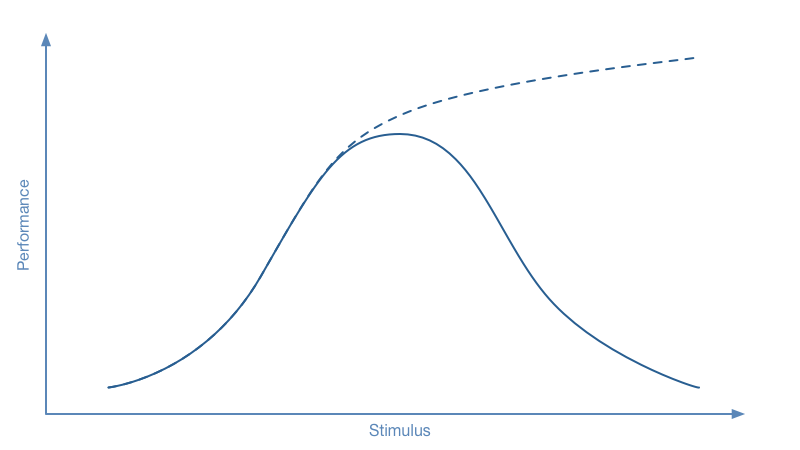If you’ve driven on snowy roads, you’ve experienced the Yerkes–Dodson law.
You know that moment where you turn the wheel and the car just keeps going straight? It’s terrifying. You want to change the direction you’re heading, but you’ve lost control.
In 1908, Robert Yerkes and John Dodson, researchers at Harvard University, studied the effect of stimulus and performance. They found that with little incentive—either a carrot or a stick—habits were formed slowly. As the incentive increased, performance also increased—but (surprisingly) only to a point. With too much incentive, we become overwhelmed and distracted. Our performance then goes downhill.
There’s a sweet spot for how much change we can tolerate at a time. Too little, and we’re not uncomfortable enough to leave our comfort zone. Too much, and we refuse to leave the sanctuary of our comfort zone. (It’s called a comfort zone for a reason!)
Get it just right, and we can change—and expand our comfort zone—faster than we might imagine.

We’ve got to get outside of our comfort zone if we want to change or do anything interesting. This is where growth happens.
No one sets goals to maintain the status quo. They’re not exciting. You’re uninspired. You can’t be bothered to get off the couch.
Have you ever been encouraged by a leader to set an unrealistic goal? What happened? You knew at the start that you weren’t going to reach it, so you weren’t engaged. You went through the motions, but it probably left you feeling cynical about setting goals and possibly, change in general.
These leaders assume what Yerkes and Dodson assumed: the higher you set the goal, the more you’ll achieve. You might only achieve 80% of what you set out to achieve, or maybe 70%, or 50%, or worse. How do they respond? By setting the goal even higher to compensate.
Somewhere in-between, there’s a sweet spot. There’s enough change that you’re interested—ideally, inspired—but not so much that you head back for the couch. You start to see some early results, you push on, and you’re encouraged.
Be excited! Change is fun! You’re winning! Keep it up!
You probably want to leave the goal where it is. Don’t get caught up in the excitement and turn a successful stretch goal into an unrealistic goal. I’d rather see you shoot for 2x and hit 2.5x than shoot for 10x and hit 1.5x. Going past your target and racking up bonus points feels great. Losing momentum because you overextended yourself doesn’t.
Another option: claim victory early and set another goal. (You can set goals at any time, not just on January 1; it’s allowed.)
What do you do if you’re not on track? You’re not hitting your milestones. You’re behind schedule. You’re going to come up short.
Take a deep breath.
Now go with it.
Sometimes we put the target in the wrong place because we didn’t have enough information to tell the difference between a stretch target and an unrealistic target. Most people would give up right there. You didn’t. You made a decision based on limited information and got going. Now you can make a better decision.
Don’t double down and dangle a bigger carrot out in front of yourself—or reach for a bigger stick! The current reward (or threat) is already part of what’s overwhelming you. Do you really think that upping the stakes will make things better?
Goals can be adjusted. They can be revised up or down. It’s a complex calculus, but if you’re feeling overwhelmed and discouraged, you’re on the right-hand side of the Yerkes–Dodson curve. Adjust the goal to get back on top.
Goals are about change. You can’t change all at once, but you do need to change.
If you don’t turn the wheel, nothing’s going to change. If you turn the wheel too sharply, you’ll lose control.
Easy goals are boring. Impossible goals are frustrating. Challenging goals facilitate growth.
Question: How do you find the sweet spot? Share your thoughts in the comments, on Twitter, LinkedIn, or Facebook.

